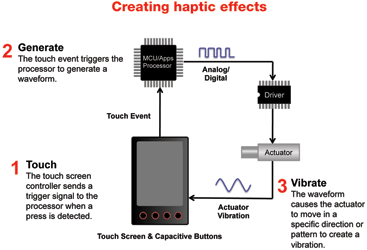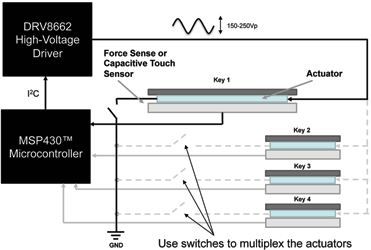
The following is a continuation from Part 1 in Dataweek 8 April, in which an overview of haptics technology and its advances is provided.
Haptic system components
The elements of a haptic system (Figure 3) include a sensor-switch, such as a key on a touchpad, which accepts the external input stimulus and sends a signal to the system microcontroller (MCU). In addition to its other processing functions, the MCU generates an output waveform, which a driver amplifies to the appropriate voltage and sends to an actuator. In the actuator an appropriate mechanical vibration for the bump, click, swipe or whatever is created.

The only devices added for haptic effects are the driver and actuator; other devices are already part of the system. In addition, the system requires software for the MCU to generate the waveform as a constant voltage, sine-wave or pulse-width modulator (PWM) driven waveform, depending on the actuator type and properties.
The haptic devices themselves must feature a high level of integration and a small footprint, since a human interface is limited in scale, however large the system it is meant to control. In handheld, battery-operated applications, extremely low power consumption is essential – a feature that is beneficial in wired systems as well, though less significant.
Since haptic technology is a new area of design for almost everyone, the IC hardware has to be easy to design into new systems and add onto existing ones, and the software must be straightforward to operate using standard MCU interfaces. Moreover, because technology applications are growing, system developers need haptic solutions from IC providers who will continue to offer more advanced options in their products in the years ahead.
TI haptic solutions
As the industry’s leading provider of analog technology, including sensors and drivers for system interfaces, TI has spent years developing an extensive portfolio of solutions to help system developers introduce differentiated haptic features in their products quickly and economically.
TI haptic drivers support ERMs, LRAs and piezo actuators that can be used for applications ranging from handheld consumer electronics to industrial robots, from intelligent building management to the latest automobiles. Unlike traditional motor drivers, these devices are designed specifically for driving haptic actuators, simplifying the design process by eliminating unnecessary functions and their software controls.
All parts needed for haptic driving are already integrated, including the high voltages required for piezo actuators (Figure 4). Any type of touch input can be used, making the drivers extremely versatile in new haptic applications.

Essential features for haptic effects are designed into the drivers to improve performance and simplify design. Among these features are automatic closed-loop feedback to improve response from ERMs and LRAs, automatic calibration that detects and configures the closed-loop feedback coefficients for every actuator, and auto-resonance detection to sense the resonant frequency of LRAs.
Ready-made waveform effects such as clicks, buzzes and ramps come with the drivers, and the developer can create custom waveforms to make software prototyping easy. Integrated diagnostics simplify design and aid in rapid testing for manufacture. TI’s advanced manufacturing process technologies keep power requirements for its haptic drivers to the minimum needed for full functionality.
TI offers reference designs for smartphones, computer mice, touchscreens, refrigerator control panels, watches, HMI, handheld barcode scanners, industrial mobile computing, and other applications. The company also collaborates with its extensive network of third parties to deliver additional system design and integration support.
Because of TI’s broad product line, it provides other major system components such as ultra-low-power MCUs, analog front-ends and power management devices, simplifying the IC selection process for developers. In addition, the company’s ongoing research efforts mean that it will be well positioned to support new developments in haptic technology, such as polymer-based actuators and haptic effects based on electrical stimulus.
Staying in touch
As we rely more and more on touchpads, flat control panels and other electronic user interfaces, increasingly we will need tactile feedback to help us understand what systems are doing. Haptic technology not only makes our experiences more satisfying, it also helps improve control, extends functionality and enhances safety for system users, while helping manufacturers to differentiate their products.
For more information contact Erich Nast, Avnet South Africa, +27 (0)11 319 8600, [email protected], www.avnet.co.za
© Technews Publishing (Pty) Ltd | All Rights Reserved